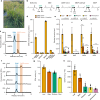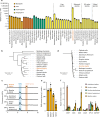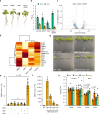Elucidation of Spartina dimethylsulfoniopropionate synthesis genes enables engineering of stress tolerant plants
- PMID: 39384757
- PMCID: PMC11464771
- DOI: 10.1038/s41467-024-51758-z
Elucidation of Spartina dimethylsulfoniopropionate synthesis genes enables engineering of stress tolerant plants
Abstract
The organosulfur compound dimethylsulfoniopropionate (DMSP) has key roles in stress protection, global carbon and sulfur cycling, chemotaxis, and is a major source of climate-active gases. Saltmarshes are global hotspots for DMSP cycling due to Spartina cordgrasses that produce exceptionally high concentrations of DMSP. Here, in Spartina anglica, we identify the plant genes that underpin high-level DMSP synthesis: methionine S-methyltransferase (MMT), S-methylmethionine decarboxylase (SDC) and DMSP-amine oxidase (DOX). Homologs of these enzymes are common in plants, but differences in expression and catalytic efficiency explain why S. anglica accumulates such high DMSP concentrations and other plants only accumulate low concentrations. Furthermore, DMSP accumulation in S. anglica is consistent with DMSP having a role in oxidative and osmotic stress protection. Importantly, administration of DMSP by root uptake or over-expression of Spartina DMSP synthesis genes confers plant tolerance to salinity and drought offering a route for future bioengineering for sustainable crop production.
© 2024. The Author(s).
Conflict of interest statement
The authors declare no competing interests.
Figures




Similar articles
-
Evolution of DMSP (dimethylsulfoniopropionate) biosynthesis pathway: Origin and phylogenetic distribution in polyploid Spartina (Poaceae, Chloridoideae).Mol Phylogenet Evol. 2017 Sep;114:401-414. doi: 10.1016/j.ympev.2017.07.003. Epub 2017 Jul 8. Mol Phylogenet Evol. 2017. PMID: 28694102
-
Biochemical evidence for two novel enzymes in the biosynthesis of 3-dimethylsulfoniopropionate in Spartina alterniflora.Plant Physiol. 2000 Jul;123(3):1153-61. doi: 10.1104/pp.123.3.1153. Plant Physiol. 2000. PMID: 10889264 Free PMC article.
-
Alternative dimethylsulfoniopropionate biosynthesis enzymes in diverse and abundant microorganisms.Nat Microbiol. 2024 Aug;9(8):1979-1992. doi: 10.1038/s41564-024-01715-9. Epub 2024 Jun 11. Nat Microbiol. 2024. PMID: 38862603 Free PMC article.
-
Molecular discoveries in microbial DMSP synthesis.Adv Microb Physiol. 2023;83:59-116. doi: 10.1016/bs.ampbs.2023.03.001. Epub 2023 Jun 1. Adv Microb Physiol. 2023. PMID: 37507162 Review.
-
Dimethylsulfoniopropionate (DMSP): From Biochemistry to Global Ecological Significance.Annu Rev Microbiol. 2024 Nov;78(1):513-532. doi: 10.1146/annurev-micro-041222-024055. Epub 2024 Nov 7. Annu Rev Microbiol. 2024. PMID: 39231449 Review.
Cited by
-
A million shades of green: understanding and harnessing plant metabolic diversity.EMBO J. 2025 Aug;44(16):4409-4418. doi: 10.1038/s44318-025-00496-z. Epub 2025 Jul 3. EMBO J. 2025. PMID: 40610793 Free PMC article. Review.
References
-
- Kirst, G. O. Salinity Tolerance of Eukaryotic Marine Algae. Annu. Rev. Plant Physiol. Plant Mol. Biol.41, 21–53 (1990).
-
- Karsten, U., Kück, K., Vogt, C. & Kirst, G. O. Dimethylsulfoniopropionate Production in Phototrophic Organisms and its Physiological Functions as a Cryoprotectant. in Biological and Environmental Chemistry of DMSP and Related Sulfonium Compounds (eds. Kiene, R. P., Visscher, P. T., Keller, M. D. & Kirst, G. O.) 143–153. 10.1007/978-1-4613-0377-0_13 (Springer US, Boston, MA, 1996).
-
- Sunda, W., Kieber, D. J., Kiene, R. P. & Huntsman, S. An antioxidant function for DMSP and DMS in marine algae. Nature418, 317–320 (2002). - PubMed
-
- Wolfe, G. V. & Steinke, M. Grazing-activated production of dimethyl sulfide (DMS) by two clones of Emiliania huxleyi. Limnol. Oceanogr.41, 1151–1160 (1996).
Publication types
MeSH terms
Substances
Associated data
Grants and funding
- NE/V000756/1/RCUK | Natural Environment Research Council (NERC)
- NE/V000756/1/RCUK | Natural Environment Research Council (NERC)
- NE/V000756/1/RCUK | Natural Environment Research Council (NERC)
- NE/S007334/1/RCUK | Natural Environment Research Council (NERC)
- MR/T044020/1/RCUK | Natural Environment Research Council (NERC)
- NE/V000756/1/RCUK | Natural Environment Research Council (NERC)
- NE/V000756/1/RCUK | Natural Environment Research Council (NERC)
- NE/P012671/RCUK | Natural Environment Research Council (NERC)
- NE/S001352/RCUK | Natural Environment Research Council (NERC)
- NE/X000990/RCUK | Natural Environment Research Council (NERC)
- NE/X014428/RCUK | Natural Environment Research Council (NERC)
- BB/X005968/1/RCUK | Biotechnology and Biological Sciences Research Council (BBSRC)
- BB/X005968/1/RCUK | Biotechnology and Biological Sciences Research Council (BBSRC)
- BB/X005968/1/RCUK | Biotechnology and Biological Sciences Research Council (BBSRC)
- BB/T008717/1/RCUK | Biotechnology and Biological Sciences Research Council (BBSRC)
- BB/T008717/1/RCUK | Biotechnology and Biological Sciences Research Council (BBSRC)
- BB/X005968/1/RCUK | Biotechnology and Biological Sciences Research Council (BBSRC)
- RPG-2020-413/Leverhulme Trust
LinkOut - more resources
Full Text Sources

